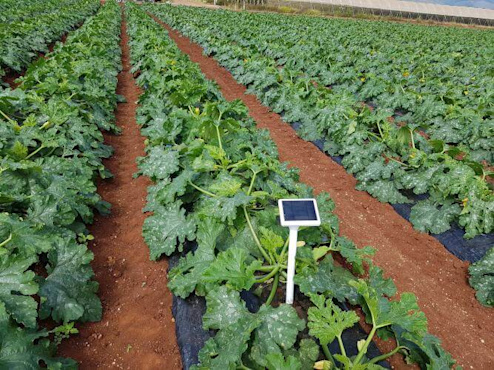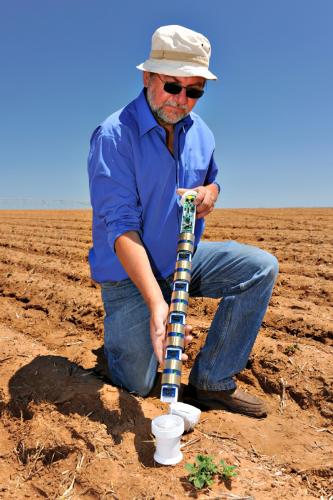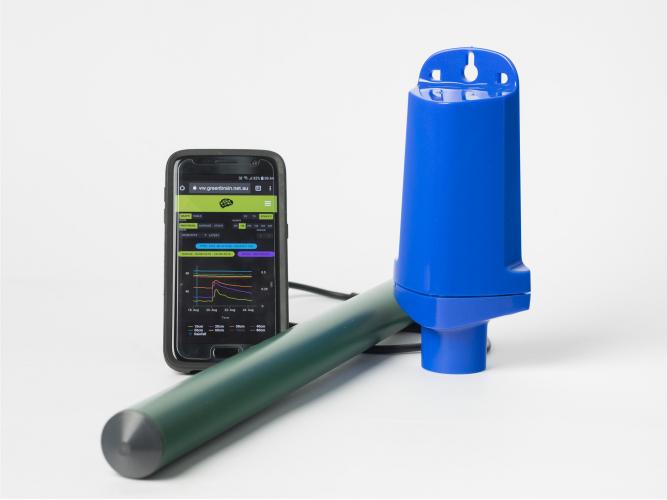
Farming in Australia’s variable climate means it’s critical to preserve and utilise every bit of available moisture. Water is the limiting factor in rainfed cropping systems. While growing season rainfall is a major factor in the ultimate yield of a crop, the water-holding capacity of the soils also plays a role. Over the past couple of decades, soil moisture has increasingly come into focus for farmers, with measures such as zero till and stubble retention being employed to improve infiltration and reduce evaporation.

The Pycno Core Sensor.
Are soil moisture sensors for you?
Farmers can keep track of their soil moisture using soil moisture sensors, or moisture probes. Having an improved understanding of soil water gives them a better understanding of the yield potential of their crops, and therefore allows better decision-making around whether to apply inputs such as nitrogen, and if so, how much.
Soil moisture sensors are fairly standard now in irrigated cropping systems, but increasingly, dryland farmers are looking to better understand their soil moisture as well. There is a range of soil moisture probe providers and the units are coming down in price as the technology improves. The units themselves are becoming more reliable and robust.
So how do you decide whether a soil moisture probe can add value to your farm business? And if you do want to install them, how do you decide which devices to choose and how much to pay? Once that is decided, how and where should they be installed, and how do you interpret the data they generate?
Any agtech solution should solve a problem on your farm, so consider what problems a sensor may solve for you. When installing soil moisture sensors, start with a just a few devices before deciding whether to roll out probes right across your property or properties.

The EnviroSCAN Soil Moisture Probe from Sentek.
Connectivity
One thing that is important to consider is connectivity – soil moisture sensors rely on connectivity to send their data. There are a number of options available in varying stages of commercialisation, and the market is evolving quickly, so it is advisable to do some research on the best option for your operations. Not all options may be available to you, and coverage may be limited or expensive in your area.
Connectivity options include:
Mobile
WiFi
LoRaWAN
Low Orbit Satellite
NarrowBand Internet of Things
Site selection
Choosing appropriate sites for your soil moisture sensors can be tricky because the sensor relays data to an adjacent telemetry unit or ‘base station’, either via cable or wirelessly. Because proximity to the base station is important, the probe often needs to go near the edge of a paddock, which may not necessarily be the most representative location for that paddock’s soils. Some compromises may be required. If cables are in use, care needs to be taking during operations such as top dressing or spraying.
Using the moisture data
The first year of installation will usually be focused on recording the plant available water capacity (PAWC), or ‘the size of the bucket’ at the site. Getting a full picture of what is going on in your soils make take three or four years.
Essentially, sensors display the soil moisture levels relative to an upper limit (soil saturation) and a lower limit (the onset of plant stress). Graphs are usually ‘stacked’ and show how the soil moisture has tracked over time. This allows the farmer to see how much moisture a crop draws down as it fills grain in the spring, i.e. how fast a crop is using moisture.
As the plants’ roots move deeper, they extract moisture during the day and shut down at night and the next sensor down will exhibit ‘stepping’ as the roots move deeper. This can be useful to show where the roots are active and help with decisions such as whether to top-dress fertiliser. For example, if the top layers of soil have dried out and the roots are active much further down (beyond 60cm), an application of nitrogen may not provide value, because it would rely on significant rainfall to move the nutrients through to the layer where the roots are active.
Longer term, understanding how long a full profile of soil moisture lasts in normal spring conditions provides farmers with essential information during the growing season. By adding further options such as rain gauges and weather stations, farmers can build a comprehensive picture that allows them to make decisions around crop management with more confidence.

GBL Bluetooth (GBL-B) is a data recorder used for soil moisture monitoring from Measurement Engineering Australia.
AgTech Finder soil moisture solutions
There are over 30 different soil moisture sensor products from agtech vendors listed on AgTech Finder. Explore a solution to suit your on-farm needs.



